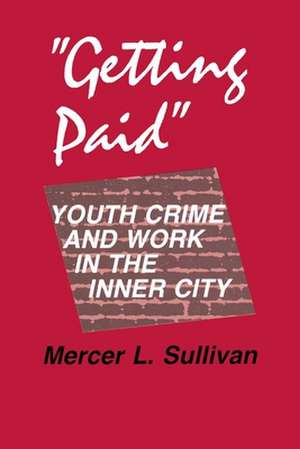"Getting Paid" – Youth Crime and Work in the Inner City: The Anthropology of Contemporary Issues
Autor Mercer L. Sullivanen Limba Engleză Hardback – 4 ian 1990
--Elliott J. Gorn, Miami University
Din seria The Anthropology of Contemporary Issues
-
 Preț: 189.58 lei
Preț: 189.58 lei -
 Preț: 177.27 lei
Preț: 177.27 lei -
 Preț: 268.40 lei
Preț: 268.40 lei -
 Preț: 229.08 lei
Preț: 229.08 lei -
 Preț: 299.91 lei
Preț: 299.91 lei - 27%
 Preț: 718.55 lei
Preț: 718.55 lei - 27%
 Preț: 726.00 lei
Preț: 726.00 lei - 27%
 Preț: 718.98 lei
Preț: 718.98 lei -
 Preț: 164.90 lei
Preț: 164.90 lei -
 Preț: 168.55 lei
Preț: 168.55 lei -
 Preț: 262.40 lei
Preț: 262.40 lei -
 Preț: 443.76 lei
Preț: 443.76 lei - 27%
 Preț: 718.14 lei
Preț: 718.14 lei -
 Preț: 164.52 lei
Preț: 164.52 lei - 27%
 Preț: 721.09 lei
Preț: 721.09 lei -
 Preț: 164.35 lei
Preț: 164.35 lei -
 Preț: 263.20 lei
Preț: 263.20 lei -
 Preț: 293.67 lei
Preț: 293.67 lei -
 Preț: 277.01 lei
Preț: 277.01 lei -
 Preț: 143.73 lei
Preț: 143.73 lei -
 Preț: 163.38 lei
Preț: 163.38 lei -
 Preț: 171.48 lei
Preț: 171.48 lei -
 Preț: 298.40 lei
Preț: 298.40 lei -
 Preț: 468.78 lei
Preț: 468.78 lei - 27%
 Preț: 718.70 lei
Preț: 718.70 lei -
 Preț: 296.57 lei
Preț: 296.57 lei - 27%
 Preț: 717.43 lei
Preț: 717.43 lei - 27%
 Preț: 721.20 lei
Preț: 721.20 lei - 27%
 Preț: 725.43 lei
Preț: 725.43 lei -
 Preț: 169.90 lei
Preț: 169.90 lei - 27%
 Preț: 722.48 lei
Preț: 722.48 lei -
 Preț: 160.86 lei
Preț: 160.86 lei
Preț: 450.67 lei
Nou
Puncte Express: 676
Preț estimativ în valută:
86.23€ • 90.04$ • 71.37£
86.23€ • 90.04$ • 71.37£
Carte tipărită la comandă
Livrare economică 04-18 aprilie
Preluare comenzi: 021 569.72.76
Specificații
ISBN-13: 9780801423703
ISBN-10: 0801423708
Pagini: 320
Dimensiuni: 152 x 229 x 27 mm
Greutate: 0.59 kg
Editura: MB – Cornell University Press
Seria The Anthropology of Contemporary Issues
ISBN-10: 0801423708
Pagini: 320
Dimensiuni: 152 x 229 x 27 mm
Greutate: 0.59 kg
Editura: MB – Cornell University Press
Seria The Anthropology of Contemporary Issues
Descriere
The working class in New York City was remade in the mid-nineteenth century. In the 1820s a substantial majority of city artisans were native-born; by the 1850s three-quarters of the city's laboring men and women were immigrants. How did the influx of this large group of young adults affect the city's working class? What determined the texture...
